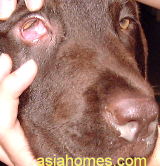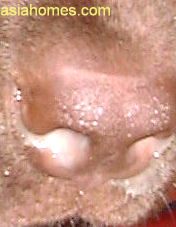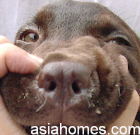Apartment Puppies
in Singapore.
The Labrador sneezed his revenge onto the vet
The new
puppy may give a dry hacking cough. It may have runny nose. If it does not
eat much and is lethargic within 24 hours, consult your veterinarian.
Be aware that your puppy-return guarantee is usually 24 hours although
some pet shops give you 48 hours after sale or longer.
 "He
was active yesterday but refused to move today. He is usually
very hungry but has no appetite now," said Ms Janet Boey. A
3-month-old handsome, thick boned chocolate Labrador retriever just
flopped on the examination table without no interest in any other dog
or people. He just wanted to sleep. His nostrils dripped a
thick yellow greenish pus continuously. "He
was active yesterday but refused to move today. He is usually
very hungry but has no appetite now," said Ms Janet Boey. A
3-month-old handsome, thick boned chocolate Labrador retriever just
flopped on the examination table without no interest in any other dog
or people. He just wanted to sleep. His nostrils dripped a
thick yellow greenish pus continuously.
I pried open his eye lids. This puppy looked like a zombie and did not
move. Was it too late to save him?
His conjunctiva or eyelid membranes were a deep red in colour. I
put a thermometer into his rectum to check if he had a fever. It
was a feverish 40 degrees Celsius.
What would be the cause of his respiratory condition? The creamy
runny nasal discharge was caused by bacterial infection. Would
there be a viral infection as well? And what virus was involved?
I ascultated his lungs with my stethoscope. His lungs were clear of
abnormal sounds. They were normal breathing sounds, not the rattling
ones heard in pneumonia. That was a good sign.
"When did he arrive in Singapore?" I asked. Viral infections show
signs and symptoms 7 - 14 days after the host succumb to its attack.
Recently, the controlling veterinary authority permits only
three-month-old puppies to be imported into Singapore.
Previously, two-month-olds had been permitted and there had been
complaints of sick puppies being sold.
 "Three of his
grandparents and great grandparents of yellow, black and chocolate
colours had won championship awards,"
Mrs Boey showed the pedigree papers and the import list of puppies
given by the pet dealer in Singapore.
"Will he die?" "Three of his
grandparents and great grandparents of yellow, black and chocolate
colours had won championship awards,"
Mrs Boey showed the pedigree papers and the import list of puppies
given by the pet dealer in Singapore.
"Will he die?"
The import papers which had a list of dogs imported was stamped 18 days
ago.
"It is hard to give a sure-to-die answer now, " I said. "His
vaccination certificate would be more useful."
He had three vaccinations, particularly, against distemper viral
infection, the most feared of all viruses of puppies as it infects the
brain and nervous system. There would be no cure if the virus
had gone to the brain. The third vaccination was done by the pet
dealer's veterinarian 16 days ago in Singapore while the other two
were done in Australia.
He was vaccinated on the first day of import.
Distemper viral infection was unlikely but could not be ruled out if
this strong looking puppy had a poor immune system. What other viral
& bacterial pathogens would cause this fever, coughing and runny nose?
 "Kennel
cough is the most likely diagnosis" I told Mrs Boey. "This puppy had
stayed in the kennel for two weeks. The dealer had hundreds of
puppies and the puppy, being stressed from the long flight from
Melbourne to Singapore would have been infected on the first few days. " "Kennel
cough is the most likely diagnosis" I told Mrs Boey. "This puppy had
stayed in the kennel for two weeks. The dealer had hundreds of
puppies and the puppy, being stressed from the long flight from
Melbourne to Singapore would have been infected on the first few days. "
I checked the vaccination certificate from its breeder in Melbourne
where most of the Singapore puppies are exported. Nno vaccination
against the kennel cough virus of Parainfluenza and the Bordetella
bacteria had been given as this would cost money.
"Any guarantee that the dealer will take back the puppy and refund you
the $1,500 if the puppy
dies?" I asked Ms Boey. $1,500 if the puppy
dies?" I asked Ms Boey.
"The guarantee was for 24 hours after purchase," said Ms Boey.
It was over 14 days post purchase. Nobody gives long guarantees
for livestock.
Blood tests would be needed to determine the severity of the
infection, but this
would add to the veterinary cost. One blood test might not
reveal anything as this was the beginning of an
infection. Bacterial and viral isolation from the nasal
 discharge
would be ideal but this would cost money. Owners always complain that
the veterinary costs are high compared to the general practitioner's
fees. Affordable veterinary treatment meant that it would be best not
to run laboratory tests. discharge
would be ideal but this would cost money. Owners always complain that
the veterinary costs are high compared to the general practitioner's
fees. Affordable veterinary treatment meant that it would be best not
to run laboratory tests.
This was a typical case of kennel cough. A hacking cough. Fever.
Nose discharge. Dullness and lethargy indicated fever. I recommended that the
puppy be given 3 days of antibiotics.
Whether the yellow-eyed puppy
would survive or not, I had to wait the next 3 days to see.
He looked stronger 48 hours after injection when I did a house-call.
Not much nasal discharge. His rectal temperature was normal. Active.
Finished his feed twice per day.
This time he resisted me checking his eyelid
colour and other examination procedures. His eye membranes were
not blood shot as his body temperature was normal. When I
pressed his nostrils and checked his nasal sinuses. He struggled and
then, he sneezed out some
light coloured discharge onto my face and white shirt. It was good to see that he was so active, as all Labrador puppies
usually are. He should recover and be a very strong and handsome
dog.
NOTE:
Around 90% of new puppies do not cough, in my observation. A common
veterinary complaint of newly
purchased puppies of various breeds is coughing. "As if the puppy is trying to throw up
something, but nothing comes out of its mouth" is the common telephone
query to me. Many of them do recover from kennel cough within 14 days.
Unfortunately, a small number do die from lung infections of
pneumonia. This might be a distemper viral infection or a
severe bacterial infection which the young puppy had no resistance.
The best advice is to consult your vet early.
Extracts from the
Asiahomes.com Book:
Apartment Puppies in Singapore: How Singaporeans care for their
puppies.
Dr Sing Kong Yuen, BVMS (Glasgow), MRCVS.
Buyers interested in this book to be published in 2004, email to
judy@asiahomes.com or tel
9668-6468.
|
 "He
was active yesterday but refused to move today. He is usually
very hungry but has no appetite now," said Ms Janet Boey. A
3-month-old handsome, thick boned chocolate Labrador retriever just
flopped on the examination table without no interest in any other dog
or people. He just wanted to sleep. His nostrils dripped a
thick yellow greenish pus continuously.
"He
was active yesterday but refused to move today. He is usually
very hungry but has no appetite now," said Ms Janet Boey. A
3-month-old handsome, thick boned chocolate Labrador retriever just
flopped on the examination table without no interest in any other dog
or people. He just wanted to sleep. His nostrils dripped a
thick yellow greenish pus continuously.  ©Asiahomes
Internet 09 Dec 2003.
Focus: Affordable
internet property and pet advertisements
©Asiahomes
Internet 09 Dec 2003.
Focus: Affordable
internet property and pet advertisements


